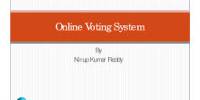Introduction
In the late 1960s, one of the authors (HMD) was a graduate student at MIT. His research at MIT’s Project Mac (now the Laboratory for Computer Science-the home of the World Wide Web Consortium) was funded by ARPA- the Advanced Research Projects Agency of the Department of Defense. ARPA sponsored a conference at which several dozen ARPA-funded graduate students were brought together at the University of Illinois at Urbana-Champaign to meet and share ideas. During this conference, ARPA rolled out the blueprints for networking the main computer systems of about a dozen ARPA-funded universities and research institutions. They were to be connected with communications lines operating at a then-stunning 56KB (1K=1024 bits per second; a bit is a single piece of data-either a zero or a one), at a time when most people (of the few who could be) were
Connecting over telephone lines to computers at a rate of 110 bits per second. HMD vividly recalls the excitement at that conference. Researchers at Harvard talked about communicating with the Univac 1108 supercomputer across the country at the University of Utah to handle calculations related to their computer graphics research. Many other intriguing possibilities were raised. Academic research was about to take a giant leap forward. Shortly after this conference, ARPA proceeded to implement what quickly became called the ARPAnet, the grandparent of today’s Internet.
Things worked out differently than originally planned. Although the ARPAnet did enable researchers to share each others’ computers, its chief benefit proved to be the capability of quick and easy communication via what came to be known as electronic mail (e-mail). This is true even today on the Internet, with e-mail facilitating communication among hundreds of millions of people worldwide.
Understanding the Internet/Intranet
Internet and Intranet are common terms in today’s IT world, but many people are still unclear of the difference between the two.
Internet
The Internet is simply a public access Wide Area Network, linking several million computers around the world. The Internet, or Information Superhighway, is the backbone which links together a huge range of information resources such as new services, corporate catalogues, bulletin boards and library archives, that can be delivered directly to the user’s desktop. As an example, an Internet user in Bangladesh can log onto machines and servers in America or Australia, in order to browse and download information on millions of topics.
There are various ways that users can access this information, but the most popular and user friendly way is to use the World Wide Web. There are thousands of Web Servers on the Internet, each one presenting users with formatted ‘pages’ of text, sound and graphic based information. Using what is referred to as a Web browser, users can navigate this World Wide Web o linked information, using a ‘point and click’ windows based graphical user interface.
Intranet
Rather than viewed as competition to the Internet, an Intranet can be viewed quite simply as a private internal company Internet. If we think of the Intranet as an open public service, an Intranet is an organization’s private version of it, i.e. information contained in a hypermedia based format, but only available to people within the organization rather than millions of users around the world.
When a company invests in an Intranet, its users have access to internal online data in a Web based environment. By using a browser a user can search through the contents of the company’s Intranet. This means that information becomes on-line, making it easier to distribute, update and obtain and replaces the need to distribute large amounts of paper.
E-mail (electronic mail) is the transmission of messages and files via computer network. E-mail was one of the original services on the Internet, enabling scientists and researches working on government-sponsored projects to communicate with colleagues at other locations. Today, e-mail quickly is becoming a primary communication method for both personal and business
Using an email program, you can create, send, receive, forward, store, print and delete messages. To receive messages, you need and email address, which is a combination of a user name and a domain name that identifies.
The rationale of the Study:
The use of internet in education is very important because the student can succeed in life with the half of status they acquire through the use of internet.
But all are not conscious about internet. We must overcome this problem. Without erasing the problem it can not play a crucial role in maintaining peace and harmony among the nations, communities and the individuals.
Objective of the study:
This term paper is prepared with manifold objectives such as creation awareness of the people, find out the problems, find out the problem, its remedies and finally to make this system standard in accordance with the demand of time. These objectives may be summarized as follows:
- To find out the advantages and disadvantages of internet for the education.
- How to increase the use of internet for in the field of education.
- To explore the remedies of bad uses of internet for the young.
Scope of the term paper:
The importance of internet is accredited in all system of our country. In this topic, I tried to identify the advantage disadvantages of internet. Because if this prevailing condition is allowed to continue in this way, the quality use will be hampered. So on the whole the main problems have been identified from different sources.
In accordance with the suggestions and guidelines for the preparation of the term paper, I went through a number of reference books browsing website and journals and interviewed with some persons. I tried to make it more informative and authentic.
In this term paper I have also pointed out the objectives of the term paper, method of preparation of the term paper, source of data used, techniques applied and limitation of doing such a hazardous task within this stipulated time. Through out this paper I tried to maintain all sorts of impartiality.
Research Method
Term Paper is a research work. The methods that we generally use to do any research work are based on data collection. This data can be More over we know that for any statistical inquiry the interviewer has to make decision in the whole through it is not possible to check out the characteristic entirely. In this content I have used sample survey procedure to collect data from primary source to find out the real picture of impact of internet use on education sector.
In addition I have also maintained the procedure of direct personal interview to collect the data from primary source for this purpose. For this purpose, 1 first made some questionnaire for on education sector and guardians on internet use.
For secondary data, I have to take help of some books such as computer & information technology, computer confluence by George Beekmar, computers in today’s world by Ralph M. Stair, Jr, and different website such as www.google.com.eahoo.com. etc.
Introduction to sample
As a part of writing of this term paper I have used the samples collected in a systematic way, i.e. I have prepared a questionnaire for the respective. To achieve comparatively fare result from- the collected data, I have classified the respondent in two groups, like young and Guardians.
Methods of sample selection
Any statistical work has some specific characteristic such as sample selection. It ensure desired result from data collection through investigation, assimilation classification analysis and finally presentation of the same from a point of view. I have selected the sample in the following two methods.
(i) Direct Method:
In this stage I have selected the samples based in the necessary data collected from related fields is the above mentioned two groups of respondent by interviewing them through questionnaire.
(ii) Indirect Method:
In this stage I have selected the sample form other secondary sources like books, periodicals, journals, documents website etc.
Sources of Data Collection
In preparing the term paper I have collected data from two sources, namely.
1. Primary Source :
To specify the advantages disadvantages of internet use the students concerned and the related institutions are considered to be the only sources of data for this purpose in accordance with this primary source of my collected data are the students teachers and guardians of different institutions.
2. Secondary sources:
To verify or justify the authenticity of primary data, corresponding or parallel data from secondary source are required to be collected. So, I have used the secondary source like books, lectures, periodicals, journals, website etc.
Definitions:
A network is a collection of computers and devices connected together via communication media and devices such as cables, telephone lines, modems, and satellites. The world’s largest network is the Internet, which is a worldwide collection of networks that links together millions of businesses, government offices, educational institutions, and
The world’s largest network is the Interne, which is a worldwide collection of networks that links together millions of businesses, the government, educational individuals. Each of these networks provides resources that add to abundance of goods, services and information accessible via the Internet.
Study:
Study means a process making a report. In any kind of research, a study is highly essential. Without study no researcher can reach its goal.
Review of literature:
At time of preserving this term paper I did not get sufficient books and information. Mainly I had to gave importance on primary data. The literature which I reviewed at the time of preparing this term paper are as follows:
- Computer & Information technology: Foundation Training manual.
- Computer: training manual for secondary level subject teacher
- Computer confluence- George Beekman.
- Computer in today’s world: Ralph M. Stair Jr.
- Website, www.goole.com, www.yahoo.com.
Besides this I have used some other sources with in the short stipulated time to make my term paper a success one.
Limitation
Very pertinent issue I have been given for writing research. I was very hopeful of making this work much informative, resourceful, elaborate and analytical. I went through different libraries, institutions searching website for collecting data. I had to face some limitations that are given below:
(i) Unavailability of sufficient reference books
(ii) Very limited time while it needs much time for preparing term paper.
(iii) I was not allowed to go out for data collection during office hours.
(iv) No monetary allocation for this purpose.
(v) Very recent data on this topic are not available
(vi) The area on this term paper is very big but I had to finish the work within a very short time.
Advantages of Internet:
Today more than 400 million users around the word connect to the Internet for a variety of reasons. Some of the uses of the Internet are as follows
- To access a wealth of information, news, research, and educational material
- To conduct business or complete banking and investing transactions
- To access sources of entertainment and leisure such as online games, magazines, and vacation planning guides
- To shop for goods and services reactance, and educational
- To conduct business or complete banking and investing transactions To access sources of entertainment and leisure such as online games magazines, and vacation planning guides.
- To shop for goods and services
- To meet and converse with people around the world in discussion groups or chat rooms
- To access other computers and exchange files
- To send messages to or receive messages from other connected users
- To provide information, photograph, audio, or video
- To take a course or access other educational material.
Sports
Internet is used to analyze and design new plays, make draft picks, and handle the day-to-day business operation of any sports franchise. They have also been used to analyze the smallest movements an athlete can make. Computers have enabled experts to pinpoint wasted energy and movements for many athletic events. The result has been world records. Do you play tennis? A special tennis computer, called Comp tennis, records the important plays of a match. Then the data is used to determine how a player can improve. Computers are even used to score surfing contests. Today most colleges and universities that perform sports research have sophisticated computers.
Disadvantages of Internet for the young:
Consider the dismay of many who have finally wended their way onto the Internet. After spending money and mental energy, they look forward to meeting a whole different, better byte of people. Instead, they discover that the folks in their computerized chat groups have no more insight and wit than the people they talk to at the water cooler.
For many people, the Web is just another way to argue about O.J. And the most popular subject—dare I say the hot topic—in cyberspace is not philosophy or physics. It’s sex. We have arrived at the megabyte millennium, using our sophisticated worldwide communications systems to talk dirty to strangers. New tech, same old anxieties. Not to mention neuroses.
The promise of the high-tech communications world was that we could do things faster, easier, better. But in some ways, the swiftness with which we can now communicate ideas also seems to mock the time it still takes to form them. It’s like trying to write a haiku with a cursor blinking at you to hurry up.
A lawyer I know says that the fax machine has become her anxiety attacker. The clients who once wanted written answers to their questions by the next day’s mail, now want them faxed. The time she had to think has been reduced to the time it takes to respond. And if the client’s fax demands aren’t insistent enough, consider the boss’ e-mail.
This is not the first time that technology has left us in the dust. We’ve built cars that can travel at speeds that outstrip our control. Weapons that close arguments faster than we can buy. Cable lines and satellite dishes that outstrip our capacity to fill them with something other than junk.
Pornography.
The young also waste their valuable time by chatting, watching movie in internet.
they also lost their money.
How to increase the use of Internet for young’s welfare:
(i) Infrastructure facilities and legal framework will be created.
(ii) Develop an efficient ICT infrastructure that provides open access to international and national network.
(iii) Increase awareness of people
(iv) Government should start e – governing, e-learning, e-business etc.
To explore the remedies of bad uses of internet:
If we want to explore the remedies of bad uses of internet following steps should be taken:
(i) Morality development.
(ii) Exemplary punishment.
(iii) Awareness of guardian.
Data Analysis
1. Do you think that internet facility in our country is available?
Yes | No |
7 | 23 |
23.33% | 76.66% |
2. Why internet facility is not available?
Infrastructure | Unconscious | Lack of ICT |
20 | 04 | 06 |
66.66% | 13.33% | 20% |
3. Do you browse internet?
Yes | No |
7 | 13 |
35% | 65% |
4. How many times do you browse internet
Regularly | Twice in month | Once in month | Irregularly |
6 | 2 | 3 | 9 |
30% | 10% | 15% | 45% |
5. What advantages do you get?
Education | Job | News | Recreation | Communication |
10 | 8 | 2 | 3 | 7 |
33% | 26% | 6% | 10% | 23% |
6. What are the disadvantages at internet for young’s?
Pornography | Wasting time | Perverted | Erosion of values & norms |
20 | 5 | 2 | 10 |
66% | 16.66% | 6.66% | 33% |
Findings:
Having done the study on twenty young & ten guardian, different web site and different reference books following terms are identified:
- Most of the user’s are in urban area.
- In rural area there is a few internet facilities.
- Most of the young do not know how to use internet.
- Some use internet for research work, job searching & library work.
- Some use for business purpose.
- Some for recreation like watching movie, chatting etc.
- All the cyber cafe are in urban area.
- Most of the users do not have a personal Computer.
- internet virus sometimes destroyed valuable documents, software etc.
- It misguided some students because there is pornography.
Recommendation:
- More internet facilities should be given of the student of rural area.
- Internet facilities should be ensured in all the educational institutional of Bangladesh.
- Establish legislate and regulatory framework for ICT issues like IPR, data security and protection, digital signatures, ICT education provided by different private organizations.
- Set up national databases that are reliable and easily accessible to all the people of the country;
- Promote use of ICT by providing special allocations for ICT project implementation in the public sector. Train the decision makers in ICT use and promote a ICT culture;
- Development a large pool of world class ICT professionals to meet the needs of local and global markets;
- Set up a very high quality ICT institution to continuously promote and foster ICT Industry;
- Enact Laws and Regulations for uninterrupted growth of ICT, in conformity with World Trade Organization (WTO) stipulations.
Conclusion:
Internet is an important part of Information & Communication Technology ( ICT). It influence every aspect of our everyday life. Today’s citizens need with the technological development in the global context. Through the use of internet extensively they can on important role in building the nation and lead the action to welfare and prosperity. so Bangladesh Govt. should take necessary steps to ensure the use of intent in the field of education.
Bibliography
1. Foundation Training Manual- Part Four
2. Training Manual for Secondary level subject Teachers
3. Computer in Today’s Words-Ralph M. Stair, Jr.
4. Computer Confluences-George Beekman
5. www.yaho.com
6. www.goole.com
















